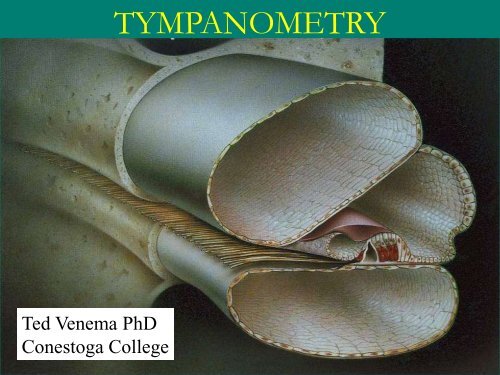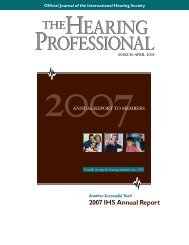Tympanometry: Methodology, Interpretation and Clinical Application
Tympanometry: Methodology, Interpretation and Clinical Application
Tympanometry: Methodology, Interpretation and Clinical Application
You also want an ePaper? Increase the reach of your titles
YUMPU automatically turns print PDFs into web optimized ePapers that Google loves.
Ted Venema PhD<br />
Conestoga College<br />
TYMPANOMETRY
Why Do We Have a Middle Ear?
To Increase Sound Pressure<br />
So airborne sound can penetrate fluid-filled Cochlea<br />
How?<br />
1. Size<br />
of TM<br />
Compared To<br />
Size<br />
of Stapes
1. Eardrum 17 times larger than stapes footplate<br />
Pressure is force/area<br />
From Martin, F., Introduction to Audiology, Allyn & Bacon, 8 th edition, 2003, fig 10.6
2. Then there’s this leverage thing…<br />
An axis runs<br />
right through<br />
here<br />
ie. ossicular chain<br />
pivots on<br />
this axis<br />
Malleus is<br />
lightly longer<br />
than incus<br />
1.3:1
The Fulcrum:<br />
Head of Malleus & Short Process of Incus<br />
An axis runs<br />
right through<br />
here<br />
Note:<br />
Malleus is 1.3 times<br />
longer than<br />
Incus long process
Middle<br />
Ear<br />
Ossicles<br />
From Yost, WA<br />
Fundamentals of<br />
Hearing<br />
(1994)
From Martin, F., Introduction to Audiology, Allyn & Bacon, 8 th edition, 2003, fig 10.6
Leverage action of ossicles is like a teeter totter<br />
It increases pressure by 1.3:1<br />
From Martin, F., Introduction to Audiology, Allyn & Bacon, 8 th edition, 2003, fig 10.7
3. Buckling Action of TM<br />
Due to its conical shape,<br />
the TM “buckles”<br />
as it vibrates…This<br />
doubles the movement<br />
of the Malleus<br />
Buckling<br />
action<br />
Annulus<br />
Annulus<br />
TM at rest<br />
Umbo
SO, IN SUMMARY<br />
The middle ear provides a sound pressure increase of 44:1<br />
1. Eardrum – stapes size: 17:1<br />
2. Ossicles leverage action: 1.3:1<br />
3. Eardrum buckling action: 2:1<br />
17<br />
1.3<br />
X 2<br />
44
dB<br />
SPL<br />
33dB<br />
120<br />
100<br />
80<br />
60<br />
40<br />
20<br />
0<br />
Middle Ear Adds 33dB to Incoming Sound<br />
It has to, Because the Cochlea is Filled with Fluid!<br />
0 10 100 1000 10,000 100,000 1,000,000<br />
44:1<br />
Pressure increase
30<br />
20<br />
10<br />
0<br />
Total Ear Canal<br />
&<br />
Concha<br />
250 500 1000 2000 4000 8000<br />
=<br />
dB<br />
SPL<br />
40<br />
25<br />
10<br />
0<br />
30<br />
20<br />
+<br />
10<br />
0<br />
Our hearing sensitivity<br />
Note how important speech Hz’s<br />
emphasized<br />
125 250 500 1000 2000 4000 8000<br />
Hz<br />
Middle Ear<br />
250 500 1000 2000 4000 8000
By the Way…Have we got this “down?”<br />
Lass & Woodford<br />
Hearing Science Fundamentals Fig 2-7
Otitis Media & Kids<br />
Their Eustachian Tubes Are More Horizontal
Normal<br />
Right<br />
Tympanic<br />
Membrane
Serous<br />
Otitis<br />
Media
Acute<br />
Bulging<br />
Otitis<br />
Media
Retracted TM<br />
Note stapes<br />
in background
From: Northern & Downs, Hearing in Children 4 th ed, Williams & Wilkins 1991
PE<br />
(pressure<br />
equalizing)<br />
Tube
For the Middle<br />
Ear to be most<br />
Efficient…<br />
Air pressure must be<br />
even on both<br />
sides of TM<br />
Key Concept of <strong>Tympanometry</strong>:<br />
Lass & Woodford<br />
Hearing Science Fundamentals Fig 2-8
Middle ear is a closed space:<br />
Quite inaccessible to scrutiny from outside<br />
<strong>Tympanometry</strong>:<br />
enables examination<br />
of closed middle ear<br />
space from the<br />
outer ear canal!
Here’s How:<br />
<strong>Tympanometry</strong> Involves Impedance<br />
•Middle ear “Impedance”is comprised of 3 things:<br />
•Mass<br />
Resonates with Low Hz’s<br />
•Stiffness<br />
Resonates with High Hz’s<br />
•Resistance<br />
Like simple friction; equal for all Hz’s in any object
•Mass<br />
Impedance & the Middle Ear:<br />
Middle ear ossicles<br />
•Stiffness<br />
Load of fluid pressure from inner ear on stapes footplate<br />
•Resistance<br />
Ligaments of middle ear ossicles<br />
•In short:<br />
Middle ear is stiffness dominated system!
When Air Pressure is equal on both sides of TM,<br />
This creates least Stiffness; most Compliance<br />
<strong>Tympanometry</strong><br />
is really a test<br />
of middle ear<br />
efficiency
<strong>Tympanometry</strong> Terms<br />
•Impedance:<br />
Reactance (opposition due to mass & stiffness)<br />
&<br />
Resistance (like simple friction; independent of Hz)<br />
•Admittance:<br />
Inverse of impedance; in middle ear this is mostly stiffness<br />
•Compliance:<br />
Inverse of stiffness; tympanometry thus tests compliance<br />
•Immittance:<br />
Generic term to encompass all of the above
Low Hz (226Hz) tone at about 70 dB SPL<br />
bounces off the normally Stiff Middle Ear system<br />
It is supposed to…<br />
That’s what you want<br />
Otherwise, you have nothing to measure!
While probe pump changes air pressure from + to –<br />
Probe Receiver “spits” out 226 Hz at 70 dB SPL…<br />
&<br />
Probe Microphone picks up what bounces back off TM
Hah!
Why the 226 Hz tone? Why not 250 Hz?<br />
True compliance at this Hz<br />
is equal to an enclosed volume of air<br />
Admittance is 1 mmho when measured in 1 cc cavity<br />
also, one can then obtain PV of ear canal in cc’s
The tympanogram shows SPL change in ear canal<br />
as air pressure<br />
in ear canal<br />
is changed<br />
From <strong>Clinical</strong> Impedance Audiometry 2 nd ed Jerger, Northern
Less SPL at the probe tip in ear canal means…<br />
more SPL<br />
is going through<br />
the middle ear!
<strong>Tympanometry</strong> (Impedance)<br />
Normally consists of Four Tests<br />
1. Tympanogram<br />
2. Static Compliance<br />
3. Physical Volume of EAM<br />
4. Acoustic Reflexes
Note<br />
Progression<br />
from Negative<br />
(type C)<br />
to Rounded<br />
to Flat<br />
From <strong>Clinical</strong> Impedance Audiometry 2 nd ed<br />
Jerger, Northern
Static Compliance<br />
According to the description below…<br />
Isn’t it just the height of the Tympanogram?<br />
From <strong>Clinical</strong> Impedance Audiometry 2 nd ed Jerger, Northern
From <strong>Clinical</strong> Impedance Audiometry 2 nd ed Jerger, Northern
Note the unusually high static compliance<br />
From <strong>Clinical</strong> Impedance Audiometry 2 nd ed Jerger, Northern
Physical Volume of ear canal<br />
Normally is between 1.0 to 1.5 cc<br />
•True Type B tympanogram has normal PV<br />
•If Type B with tiny PV, then probe tip is against EAM wall<br />
From <strong>Clinical</strong> Impedance Audiometry 2 nd ed Jerger, Northern
Acoustic<br />
Reflexes<br />
•Ipsilateral<br />
•Contralateral
Lass & Woodford<br />
Hearing Science Fundamentals Fig 2-9<br />
Location of<br />
Stapedius muscle
Location of<br />
Tensor Tympani muscle<br />
Lass & Woodford<br />
Hearing Science Fundamentals Fig 2-10
Note:<br />
if one ear gets<br />
the loud sound,<br />
the AR occurs<br />
in both ears<br />
V nerve<br />
to Tensor Tympani<br />
VII nerve<br />
to Stapedius<br />
Acoustic Reflex Arc<br />
V nerve<br />
to Tensor Tympani<br />
VII nerve<br />
to Stapedius<br />
From Martin, F.<br />
Introduction to Audiology<br />
Allyn & Bacon<br />
8 th edition, 2003
Another view of the Acoustic Reflex Arc<br />
This ear is<br />
getting the stimulus<br />
<strong>and</strong> has an AR<br />
This ear did not get<br />
the stimulus but still<br />
has an AR
Question:<br />
Why do we really have acoustic reflexes??
Musiek<br />
&<br />
Rintelmann<br />
ARs are<br />
a<br />
Low Hz<br />
Phenomenon
Answer:<br />
Not to protect against NIHL<br />
• one of the fallicies we are commonly lead to believe<br />
ARs occur especially while we speak<br />
• they actually kick in about 50 msec before we talk<br />
Note ARs strongest for low Hz’s (500, 1000Hz)<br />
• because our voices are louder for vowels<br />
ARs reduce upward spread of masking<br />
• allow us to hear high Hz’s better while talking<br />
• all mammals have them
ARs & Speech Discrimination<br />
AR deals with IHCs<br />
AR arc: IHCs send afferent information to VIII nerve<br />
IHCs are critical part of AR arc<br />
OAEs deal with OHCs<br />
Cochlea: OHCs receive efferent information<br />
OHCs not involved w/ AR arc<br />
Two people with same moderate SNHL<br />
may have very different SD<br />
One with good SD probably has ARs at reduced SLs<br />
one with poor SD probably has absent ARs
Inner hair cells<br />
Outer hair cells<br />
Hair Cells:<br />
A Closer Look<br />
Picture from Australian Hearing<br />
Hear & Now, issue 4, 1998
Normal<br />
Inner<br />
&<br />
Outer<br />
Hair Cells<br />
Fig 1-7, Venema, T.<br />
Compression for<br />
Clinicians 2 nd edition,<br />
Thomson Delmar<br />
Learning 2006
Damaged<br />
Hair<br />
Cells<br />
(mostly<br />
outer)<br />
Fig 1-8, Venema, T.<br />
Compression for<br />
Clinicians 2 nd edition,<br />
Thomson Delmar<br />
Learning 2006
The Acoustic Reflex & <strong>Tympanometry</strong><br />
With ARs, you are still using <strong>Tympanometry</strong><br />
measure how much 226 Hz tone is bouncing off TM<br />
Tympanograms change middle ear compliance by air pressures<br />
ARs change middle ear compliance by loud sounds!<br />
ARs are done at Static Compliance<br />
at the air pressure yielding highest tympanogram
Contralateral ARs were 1 st to be Developed<br />
Contralateral ARs relatively straightforward to comprehend<br />
Low-Hz tones<br />
(500 & 1000 Hz<br />
at 85-110 dB HL)<br />
are presented with<br />
headphone to one ear…<br />
ARs (temporary increases<br />
in 226 Hz SPL)<br />
measured with probe<br />
in opposite ear
Ipsilateral ARs are harder to Comprehend<br />
Loud 500 or 1000Hz tone stimuli & 226 Hz tone to measure AR<br />
are all in same ear canal at same time!<br />
Temporary increases in 226 Hz SPL) are now measured<br />
with probe in opposite ear<br />
226 Hz tone<br />
to measure AR<br />
500 or 1000 Hz<br />
AR stimulus tone<br />
Probe & Headphone
Stimulus &<br />
Probe<br />
in RE<br />
Stimulus in RE<br />
Probe in LE<br />
Katz H<strong>and</strong>book 5 th edition,<br />
page 207<br />
Acoustic reflex is always reported<br />
according to ear that got the stimulus<br />
Stimulus in LE<br />
Probe in RE<br />
Stimulus &<br />
Probe<br />
in LE
Acoustic Reflexes are measured as<br />
temporary decreases in Compliance (Admitttance)<br />
Think of a temporary drop<br />
in the Tympanogram<br />
peak (Static Compliance)<br />
while the loud AR<br />
stimulus is presented<br />
The results here are shown<br />
for a 1000 Hz tone<br />
presented for 1 second<br />
Musiek & Rintelmann<br />
Figure 5.11
ARs Reported in Sensation Level (SL)<br />
ARs tested in dB HL (tympanometer calibrated in dB HL)<br />
ARs normally found between 80-100 dB HL<br />
ARs reported in dB SL (always relative to one’s own thresholds)<br />
ARs can be tested at 500, 1000, 2000, or 4000 Hz<br />
Normal & mild-moderate SNHL<br />
may have ARs at similar dB HL<br />
but at very different SLs<br />
Eg: normal HL & flat 50 dB SNHL may have ARs at 100 dB HL<br />
but normal HL has ARs at 100 dB SL<br />
the SNHL has ARs at 50 dB SL
ARs<br />
<strong>and</strong><br />
SNHL<br />
Note:<br />
The SL for ARs<br />
tends to decrease<br />
linearly as the<br />
degree of SNHL<br />
increases (up to<br />
about 60 dB HL
SNHL<br />
<strong>and</strong><br />
Reduced<br />
SL<br />
Note:<br />
SL decreases in<br />
almost exact<br />
proportion to<br />
degree of<br />
SNHL!<br />
From <strong>Clinical</strong> Impedance<br />
Audiometry 2 nd ed<br />
Jerger, Northern
Absent ARs<br />
Note:<br />
<strong>and</strong><br />
SNHL<br />
Absence of ARs<br />
increases dramatically<br />
with SNHL of<br />
60 dB HL or more
Bilateral SNHL & ARs<br />
Katz, H<strong>and</strong>book of<br />
<strong>Clinical</strong> Audiology
Unilateral SNHL & ARs<br />
Contralateral & Ipsilateral AR are normal for both ears<br />
Katz, H<strong>and</strong>book of<br />
<strong>Clinical</strong> Audiology fig 13.18
Conductive HL tends to obliterate ARs<br />
Unilateral Conductive HL<br />
Contralateral ARs with stimulus in good ear:<br />
mechanical middle ear problems in bad ear prevent AR<br />
Contralateral ARs with stimulus in bad ear:<br />
HL in bad ear prevents intensity sufficient to cause AR in opposite ear<br />
Result: Only good ear Ipsilateral AR present
Conductive HL tends to obliterate ARs<br />
Bilateral Conductive HL<br />
Contralateral & Ipsilateral ARs all absent
Katz, H<strong>and</strong>book of <strong>Clinical</strong> Audiology
Katz, H<strong>and</strong>book of <strong>Clinical</strong> Audiology
Relationship between degree of HL <strong>and</strong> Absent ARs<br />
in SNHL vs VIII nerve pathology<br />
From: Musiek<br />
&<br />
Rintelmann
Acoustic Reflex Decay & VIII nerve pathology<br />
Stimulus Tone<br />
No Decay<br />
No Decay b/c AR<br />
reduced by





